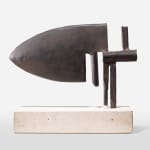-
Artworks
Julio González
Main couchée, 1937Bronze cast on stone base7 1/2 x 11 5/8 x 1 1/8 in (19 x 29.5 x 2.8 cm)© 2025 Artists Rights Society (ARS), New York / ADAGP, Paris. Courtesy of Zeit Contemporary Art, New YorkFurther images
In Main couchée (Reclining Hand), Julio González transforms the concept of the hand from a simple anatomical feature into a poetic symbol of both human creativity and the aggression of...In Main couchée (Reclining Hand), Julio González transforms the concept of the hand from a simple anatomical feature into a poetic symbol of both human creativity and the aggression of a preindustrial tool. The work, conceived in iron and cut iron slabs, evokes the image of a spade-like element with pointed rods projecting like fingers. This choice of form references ancient weapons from the Iron Age, yet through González's artistic lens, the object transcends its martial origins to become a meditation on the resilience and creativity of the human body. The piece speaks to the duality of hands as both creators and destroyers, tools for both making and unmaking, in a deeply resonant way.
Visually, Main couchée leans into abstraction, presenting a sideways disposition that sets it apart from more traditional depictions of the human form. The sharpness of its elements and its raw, industrial texture communicate an uncompromising strength, hinting at the violence inherent in both nature and human conflict. However, González’s touch is never one-dimensional. Even in its most aggressive forms, the piece maintains a lyricism—a dialogue between the rigid and the fluid, the mechanical and the organic. The hand here is not just an object but a story of movement, a journey from potential to action, and a silent witness to history's unfolding.
Historically, this sculpture was created during the Spanish Civil War, a time of intense political engagement for González. His art during this period is marked by a profound sense of solidarity with those fighting for freedom, a sentiment that echoes in the militant yet tender gestures of his works. Main couchée represents this balance—where even in the form of a weapon, there is an undeniable homage to the hand's capacity for creation and connection. The elements in this work, both raw and refined, are a metaphor for the resilience of the human spirit amidst adversity.
Through Main couchée, González turns the motif of the hand into a poetic device, using its shapes and textures to tell a story far beyond its physical reality. The transformation of a potentially aggressive object into a symbol of humanity’s enduring creativity and spirit highlights González's unique ability to see the poetry in form. His work reminds us that even the most utilitarian or violent shapes can become vessels of grace and beauty when guided by the touch of an artist deeply engaged with the world around him.
NOTES
The iron sculpture, executed circa 1937, is part of the esteemed collection of IVAM (Institut Valencià d'Art Modern) in Valencia, Spain. This sculpture was later cast in bronze in an edition of 8 numbered casts plus four marked 0, 00, EA, HC and one for the donación González (donation to the MAM Barcelona 1972, now the Museu Nacional d'Art de Catalunya), marked MAM Barcelona.
Provenance
The artist's estate
Carmen Martínez and Viviane Grimminger, Paris, France
Julio González Administration, Paris, France
Exhibitions
Paris, Galerie de France; London, Tate Gallery; Humblebaek, Louisiana Museum; Musée Fabre, Montpellier, Julio González 1876-42, les materiaux de son expression II, 1970-71, no. 65 (another example exhibited and illustrated).
London, Gimpel Fils, González, Drawings, 8 September - 3 October 1970, no. 87 (another example exhibited).
Madrid, Galeria Ruiz-Castillo, Julio González, October - November 1974 (another example exhibited and illustrated).
Vienna, Galerie Ulysses (no. 20); Städtische Kunsthalle Mannheim (no. 49), Julio González 1846-1942, Plastiken, Zeichnungen, 1977 (another example exhibited and illustrated).
Charleroi, Palais des Beaux-Arts, Julio González 1876-1942, 57 sculptures - 35 dessins, 13 November - 18 December 1977, no. 47 (another example exhibited).
Kessel/Lier, Galerij Dobbelhoef, Julio González 1876-1942, 10 November - 23 December 1979 (another example exhibited and illustrated).
New York, The Pace Gallery, Julio González, Sculpture and Drawings, 2 - 31 November 1981 (another example exhibited and illustrated).
Basel, Galerie Beyeler, González, Sculptures-Dessins, September - December 1982, no. 33 (another example exhibited and illustrated).
Frankfurt am Main, Städtische Galerie im Städelschen Kunstinstitut; Berlin, Akademie de Künste, Julio González 1876-1942 Plastiken, Zeichnungen, Kunstgerwerbe, 17 June - 23 October 1983. no. 113, p. 185 (another example exhibited and illustrated).
Lugano, Galleria Pieter Coray, Julio González, 23 September - 12 November 1983, no. 17 (another example exhibited and illustrated).Bern, Kunstmuseum Bern, Julio Gonzalez, Zeichnen in Raum (Dessiner dans l'espace), 27 June – 7 September 1997.
Barcelona, Madrid, Julio Gonzalez. Retrospectiva. Barcelona, Museu Nacional d'Art de Catalunya, 27 October 2008-25 January 2009 // Madrid, Museo Nacional Centro de Arte Reina Sofia, 10 March 2009-01 June 2009 2008 (another example exhibited).
Literature
Pierre Descargues, 'Julio González', Plaisir de France, Paris, May 1970, no. 3, p. 56 (another example illustrated).
Vicente Aguilera Cerni, Julio, Joan, Roberta Gonzalez: Itinerario De Una Dinastia, Barcelona, 1973, no. 252, p. 293 (iron example illustrated).
MAB (ed.), Donacíon González, Barcelona, 1974, no. 36 (another example illustrated).
Jörn Merkert, Julio González, Catalogue raisonné des sculptures, Milan, 1987 no. 233, p. 267 (iron example illustrated).IVAM 1993, Julio González. Las colecciones del IVAM. Nuevos fondos, Valencia, 1993, p. 48 (iron example illustrated).
Guillermo Solana, Julio González. Las colecciones del IVAM, 2000, p. 232-233 (iron example illustrated).






